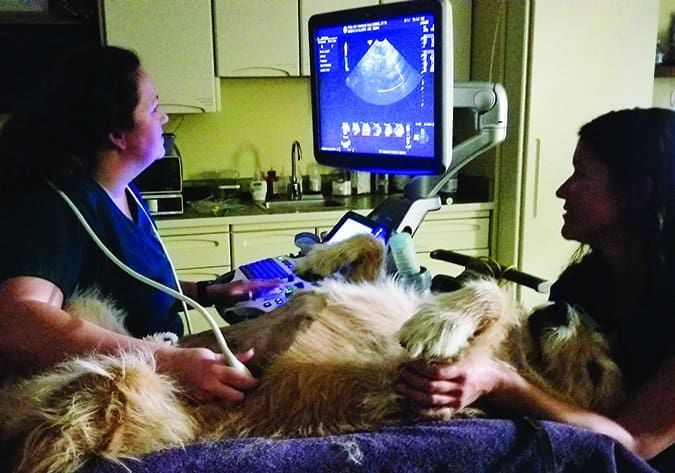Urinary tract infections (UTIs) are one of the more common problems seen in small-animal veterinary practice. The definition of a UTI is a colonization of pathological bacteria in the normally sterile environment within the urinary tract. There are many medical conditions that make a dog prone to urinary tract infections, some of which can be prevented. Knowing how to recognize the problem is the first step to getting the proper diagnosis and treatment plan for your dog.
Can Dogs Get UTIs?
The urinary tract is comprised of the kidneys, ureters, bladder, and urethra. Dogs have two bean-shaped kidneys located in the mid abdomen. The kidneys are responsible for filtering blood and excreting waste in the form of urine. As the urine is continually created, it exits each kidney via a small tube called the ureter. The ureters dive into the bladder, which is a muscular collection tank. When the dog is ready to urinate, the muscles of the bladder contract and the urine is emptied through a tube called the urethra, which transports the urine out of the dog.
Problems can develop anywhere along this path, but the most common area of concern is within the bladder itself. When referring to UTIs, veterinarians are almost always referring to infections within the lower urinary tract, or the bladder itself. Infections of the upper urinary tract, or kidneys, are more commonly referred to as pyelonephritis and are more serious in nature.

Signs of a UTI in Dogs
Signs that your dog has a urinary tract infection can be quite variable. Typically, dogs with a lower urinary tract infection do not develop a fever and behave in a normal fashion, other than changing the pattern of their urination habits. Some dogs can be completely asymptomatic, while others show dramatic urgency or frequency while voiding very small volumes of urine. Some dogs will drink excessive amounts of water, and some will lick at their genital region, especially after urinating. Occasionally, an owner will notice hematuria (blood or blood clots in their dog’s urine).
It is important to note, however, that not all dogs with increased frequency, urgency, and hematuria have a urinary tract infections. There are other medical problems that can appear clinically similar, including sterile cystitis (inflammation of the bladder without bacteria), uroliths (bladder stones), and cancer. Therefore, it is very important to make a trip to your veterinarian if you notice any change in your dog’s usual urination pattern.
UTI Diagnosis in Dogs
Diagnosing a UTI is relatively straightforward. Your veterinarian will collect a urine sample and put it through a number of tests.
Typically, the urine is first evaluated macroscopically by analyzing its color and turbidity (cloudiness or clarity). Then the urine is tested for its specific gravity (concentration). Urine that is either too dilute or too concentrated can be an important factor to consider in the analysis of the other urine values and may be an important clue in an underlying medical disorder.
Then the urine is placed on a urine test strip, which checks the biochemical nature of the urine. The pH, protein level, presence of red blood cells, white blood cells, bilirubin, glucose, and ketones are documented.
The last step is to look at the urine under the microscope. Cytology (microscopic analysis) will confirm urine-strip findings and allow for the estimation of the number of red blood cells and white blood cells. Cytologic analysis will also look for the presence of crystals, casts, and bacteria, all of which are important in the diagnosis of a UTI and other urinary-tract disorders.

A normal urine sample is sterile (does not contain bacteria). Typically, urine is a clear, light yellow color and microscopically there is very little sediment – no red or white blood cells and no bacteria present. Many parameters can change when a patient has a UTI, so all of the information from the urine test strip along with the cytology of the urine needs to be considered in the diagnosis.
By compiling all of this information your veterinarian will be able to conclude whether or not your dog has an infection of the bladder. However, she will not be able to identify the type of bacteria that caused the infection without further testing.
In order to identify the exact bacteria present, a culture will need to be performed. The urine will be collected in a sterile fashion via cystocentesis (insertion of a needle into the bladder to withdraw a small volume of urine). The urine is then placed into a sterile tube and sent to a laboratory for analysis.
At the laboratory the urine sample will be placed on a petri dish and allowed to incubate for several days. If nothing grows, then it is likely your dog does not have a bacterial urinary tract infection. If bacteria grows, the laboratory technician will identify the bacteria and give your veterinarian a susceptibility pattern, which will tell her which antibiotics will be effective for the present infection.
Pros and Cons of Different Ways to Collect Your Dog’s Urine
| URINE COLLECTION TECHNIQUE | PROS | CONS |
| FREE CATCH SAMPLE | ||
| A clean dish is used to catch urine that your pet is voiding naturally. | This is a non-stressful way to collect urine from a healthy pet for a screening analysis. |
Normal bacterial flora can contaminate urine as it passes through the penis/prepuce or across the vulva. Free-caught samples should not be used for culture. If there is a problem with the urinary tract further down the line from the bladder (prostate or urethra, for example), there may be abnormal cells picked up as the urine leaves the body. |
| CATHETERIZATION | ||
| Urine is collected by insertion of a narrow, flexible tube into the urethral orifice; the tube is then fed directly into the urinary bladder and urine is drained through the tube into a collection syringe. | This is a relatively simple procedure to collect urine if the patient is uncomfortable on his back or the bladder is too small to reach via cystocentesis. |
The procedure may be slightly uncomfortable for the patient as the catheter is fed through the urethra. Females dog are very difficult to catheterize. Sometimes bacteria can be introduced into the bladder from the insertion of the urinary catheter. |
| CYSTOCENTESIS | ||
| Urine is collected via ultrasound-guided needle insertion into the bladder; this is the gold standard for sterile urine collection. |
There is no chance for contamination from other parts of the urinary tract. It allows for visualization of the bladder with the ultrasound, which can help identify bladder masses and uroliths (bladder stones) that may be missed with a free-catch sample. |
This can be stressful for some animals because then need to be rolled onto their backs for proper restraint to perform the procedure. There is a small risk for blood contamination of the urine sample if there is bleeding from the needle insertion site. |
Causes of Urinary Tract Infections
A number of medical and physical conditions can make a patient prone to developing an infection in the urinary tract. Females are more susceptible than males for developing a UTI. Bacteria (often fecal contaminants) can more easily travel up the urethra in female dogs due to the relatively short urethral length compared to the male. Also, some female dogs have an anatomical abnormality called a “recessed” or “juvenile” vulva, where the vulva is tucked under an excessive fold of skin, creating a perfect environment for organisms to grow. If this is the case, a straightforward surgical procedure called a vulvoplasty can correct the anatomy to remove the excessive tissue and evert the vulva (make it turn outward).

In the male dog – especially the intact male – benign prostatic hypertrophy and prostatitis (infection or inflammation of the prostate gland) can make him susceptible to infection. Castration is often recommended for intact male dogs with recurrent urinary tract infections. However, sex and anatomy are not the only conditions that make dogs prone to infection.
Systemic disease and some medications can also predispose your dog to urinary tract infections. Diseases like diabetes, renal disease, Cushing’s disease, and neurologic disorders can cause UTIs. If your dog develops recurrent urinary tract infections, it may be worth investigating further to see there is an underlying predisposing medical condition. Certain medications, such as prednisone or other immunosuppressive medications, can also make a dog prone to urinary tract disease.
UTI Treatment for Dogs
Treatment for first-time urinary tract infections often involves treatment with broad spectrum antibiotics. However, as bacterial resistance becomes more commonplace in veterinary medicine, cultures are being recommended sooner than previously suggested. Checking a urine sample at the end of the course of antibiotics is wise to confirm the infection has resolved.
Following your veterinarian’s recommendations for treatment and finishing the whole course of antibiotics will help prevent against the development of resistant bacteria.
Occasionally, we see a patient with recurrent urinary tract infections. This can be very frustrating for both the dog owner and the veterinarian. Trying to identify and correct the underlying predisposition is the best course of action to prevent future recurrence. However, this is not always possible.
In these cases, supplementation is sometimes recommended. Other things you can do at home include encouraging water consumption by adding water to your dog’s food and allowing more frequent potty breaks to flush out the bladder.
Urinary tract infections, although common, are typically not very serious in nature. That said, they should never be ignored, as sometimes they are a clue to another, more serious underlying problem. Quick recognition on your part will help with a speedy diagnosis and treatment for your dog.
Supplements That Help Prevent UTIs
- Cranberry and D-Mannose have been shown to inhibit certain bacteria from binding to the bladder wall
- Probiotics help repopulate the gut and vagina with normal microbial flora
- A good-quality diet will strengthen the immune system
Lauren Brower Wacholder is an integrative veterinarian at Canyon Animal Hospital in Laguna Beach, California. She practices both conventional and integrative medicine including acupuncture, herbal medicine and cold laser therapy.






